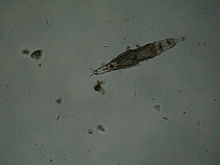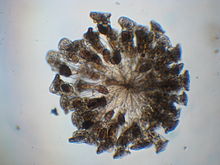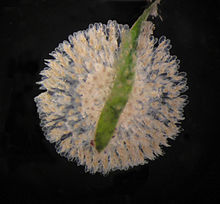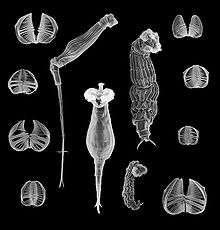- Rotifer
-
Rotifera
Temporal range: Eocene–RecentRotaria Scientific classification 
Kingdom: Animalia (unranked): Protostomia (unranked): Spiralia (unranked): Platyzoa Phylum: Rotifera
Cuvier, 1798Classes and orders - Monogononta
- Collothecida
- Flosculariida
- Ploimida
- Seisonidea
- Seisonida
The rotifers (Rotifera, commonly called wheel animals) make up a phylum of microscopic and near-microscopic pseudocoelomate animals. They were first described by Rev. John Harris in 1696, and other forms were described by Anton van Leeuwenhoek in 1703.[1] Most rotifers are around 0.1–0.5 mm long (although their size can range from 50 μm to over 2 millimeters),[2] and are common in freshwater environments throughout the world with a few saltwater species; for example, those of genus Synchaeta. Some rotifers are free swimming and truly planktonic, others move by inchworming along a substrate, and some are sessile, living inside tubes or gelatinous holdfasts that are attached to a substrate. About 25 species are colonial (e.g., Sinantherina semibullata), either sessile or planktonic. Rotifers are an important part of the freshwater zooplankton, being a major foodsource and with many species also contributing to the decomposition of soil organic matter.[3] Most species of the rotifers are cosmopolitan, but there are also some endemic species, like Cephalodella vittata to Lake Baikal.[4]
In some recent treatments, rotifers are placed with acanthocephalans in a larger clade called Syndermata.
Contents
Taxonomy and naming
Rev. John Harris first described the rotifers (in particular the Bdelloid Rotifer) in 1696 as "an animal like a large maggot which could contract itself into a spherical figure and then stretch itself out again; the end of its tail appeared with a forceps like that of an earwig".[1] In 1702, Anton van Leeuwenhoek gave a detailed description of Rotifer vulgaris and subsequently described Melicerta ringens and other species.[5] He was also the first to publish observations of the revivification of certain species after drying. Other forms were described by other observers, but it wasn't until the publication of Christian Gottfried Ehrenberg's Die Infusionsthierchen als vollkommene Organismen in 1838 that the rotifers were recognized as being multicellular animals.[5]
About 2200 species of rotifers have been described. Their taxonomy is currently in a state of flux. One treatment places them in the phylum Rotifera, with three classes: Seisonidea, Bdelloidea and Monogononta.[6] The largest group is the Monogononta, with about 1500 species, followed by the Bdelloidea, with about 350 species. There are only two known species of Seisonidea.[7]
The Acanthocephala, previously considered to be a separate phylum, have been demonstrated to be modified rotifers. The exact relationship to other members of the phylum has not yet been resolved.[8] One possibility is that the Acanthocephala are closer to the Bdelloidea and Monogononta than to the Seisonidea; the corresponding names and relationships are shown in the cladogram below.
Syndermata Seisonida
Rotifera Bdelloidea
Monogonata
Acanthocephala
The Rotifera are reduced to the Bdelloidea and the Monogonata. Rotifera, Acanthocephala and Seisonida make up a clade called Syndermata.[9]
Etymology
The word "rotifer" is derived from a Latin word meaning "wheel-bearer",[10] due to the corona around the mouth that in motion resembles a wheel (though the organ does not actually rotate).
Anatomy
Colonial rotifers, tentatively identified as Conochilius from Lake Pontchartrain, Louisiana. The colony is somewhat less than 1 mm in diameter, but visible to the naked eye.
Rotifers have bilateral symmetry and a variety of different shapes. The body of a rotifer is divided into a head, trunk, and foot, and is typically somewhat cylindrical. There is a well-developed cuticle, which may be thick and rigid, giving the animal a box-like shape, or flexible, giving the animal a worm-like shape; such rotifers are respectively called loricate and illoricate. Rigid cuticles are often composed of multiple plates, and may bear spines, ridges, or other ornamentation.
The most distinctive feature of rotifers is the presence of a ciliated structure, called the corona, on the head. In the more primitive species, this forms a simple ring of cilia around the mouth from which an additional band of cilia stretches over the back of the head. In the great majority of rotifers, however, this has evolved into a more complex structure.
Modifications to the basic plan of the corona include alteration of the cilia into bristles or large tufts, and either expansion or loss of the ciliated band around the head. In genera such as Collotheca, the corona is modified to form a funnel surrounding the mouth. In many species, such as Testudinella, the cilia around the mouth have disappeared, leaving just two small circular bands on the head. In the bdelloids, this plan is further modified, with the upper band splitting into two rotating wheels, raised up on a pedestal projecting from the upper surface of the head.[11]
The trunk forms the major part of the body, and encloses most of the internal organs. The foot projects from the rear of the trunk, and is usually much narrower, giving the appearance of a tail. The cuticle over the foot often forms rings, making it appear segmented, although the internal structure is uniform. Many rotifers can retract the foot partially or wholly into the trunk. The foot ends in from one to four toes, which, in sessile and crawling species, contain adhesive glands to attach the animal to the substratum. In many free-swimming species, the foot as a whole is reduced in size, and may even be absent.[11]
Digestive system
The coronal cilia create a current that sweeps food into the mouth. The mouth opens into a characteristic chewing pharynx (called the mastax), sometimes via a ciliated tube, and sometimes directly. The pharynx has a powerful muscular wall and contains tiny, calcified, jaw-like structures called trophi. The shape of the trophi varies between different species, depending partly on the nature of their diet. In suspension feeders, the trophi are covered in grinding ridges, while in more actively carnivorous species, they may be shaped like forceps to help bite into prey. In some ectoparasitic rotifers, the mastax is adapted to grip onto the host, although, in others, the foot performs this function instead.[11]
Behind the mastax lies an oesophagus, which opens into a stomach where most of the digestion and absorption occurs. The stomach opens into a short intestine that terminates in a cloaca on the posterior dorsal surface of the animal. Up to seven salivary glands are present in some species, emptying to the mouth in front of the oesophagus, while the stomach is associated with two gastric glands that produce digestive enzymes.[11]
A pair of protonephridia open into a bladder that drains into the cloaca. These organs expel water from the body, helping to maintain osmotic balance.[11]
Nervous system
Rotifers have a small brain, located just above the mastax, from which a number of nerves extend throughout the body. The number of nerves varies between species, although the nervous system usually has a simple layout. Close to the brain lies a retrocerebral organ, consisting of two glands either side of a medial sac. The sac drains into a duct that divides into two before opening through pores on the uppermost part of the head. Its function is unclear.[11]
Rotifers typically possess one or two pairs of short antennae and up to five eyes. The eyes are simple in structure, sometimes with just a single photoreceptor cell. In addition, the bristles of the corona are sensitive to touch, and there are also a pair of tiny sensory pits lined by cilia in the head region.[11]
Biology
The coronal cilia pull the animal, when unattached, through the water.
Like many other microscopic animals, adult rotifers frequently exhibit eutely—they have a fixed number of cells within a species, usually on the order of 1,000.
Bdelloid rotifer genomes contain two or more divergent copies of each gene, suggesting a long-term asexual evolutionary history.[12] For example, four copies of hsp82 are found. Each is different and found on a different chromosome excluding the possibility of homozygous sexual reproduction.
Like nemertine worms, the rotifers have not been proven to be derived from cilia. Its thin lamellae resemble cabbage leaves, and are composed from their creases of the receptor membrane.[vague][13]
Feeding
Video of rotifer feeding, probably of the genus Cephalodella Video of a bdelloid rotifer feeding
Video of a bdelloid rotifer feeding
Rotifers eat partuculate organis detritus, dead bacteria, algae, and protozoans. They eat particles up to 10 micrometres in size. Like crustaceans, rotifers contribute to nutrient recycling. For this reason, they are used in fish tanks to help clean the water, to prevent clouds of waste matter. Rotifers affect the species composition of algae in ecosystems through their choice in grazing. Rotifers may be in competition with cladocera and copepods for phytoplanktonic food sources.
Reproduction and life cycle
Rotifers are dioecious and reproduce sexually or parthenogenetically. They are sexually dimorphic, with the females always being larger than the males. In some species, this is relatively mild, but in others the female may be up to ten times the size of the male. In parthenogenetic species, males may be present only at certain times of the year, or absent altogether.[11]
The female reproductive system consists of one or two ovaries, each with a vitellarium gland that supplies the eggs with yolk. Together, each ovary and vitellarium form a single syncitial structure in the anterior part of the animal, opening through an oviduct into the cloaca.[11]
Males do not usually possess a functional digestive system, and are therefore short-lived, often already being sexually fertile at birth. They have a single testis and sperm duct, associated with a pair of glandular structures referred to as "prostates" (although they are unrelated to the vertebrate organ of the same name). The sperm duct opens into a gonopore at the posterior end of the animal, which is usually modified to form a penis. The gonopore is homologous to the cloaca of females, but in most species has no connection to the vestigial digestive system, which lacks an anus.[11]
Fertilisation is internal. The male either inserts his penis into the female's cloaca or uses it to penetrate her skin, injecting the sperm into the body cavity. The egg secretes a shell, and is attached either to the substratum, nearby plants, or the female's own body. A few species, such as Rotaria, are ovoviviparous, retaining the eggs inside their body until they hatch.[11]
Most species hatch as miniature versions of the adult. Sessile species, however, are born as free-swimming larvae, which closely resemble the adults of related free-swimming species. Females grow rapidly, reaching their adult size within a few days, while males typically do not grow in size at all.[11]
The life span of monogonont females varies from a couple of days to about three weeks.
Loss of sexual reproduction
‘Ancient asexuals’: Bdelloid rotifers are assumed to have reproduced without sex for many millions of years. Males are absent within the species, and females reproduce only by parthenogenesis.
Recent transitions: Loss of sexual reproduction can be inherited in a simple Mendelian fashion in the monogonont rotifer Brachionus calyciflorus: This species can normally switch between sexual and asexual reproduction (cyclical parthenogenesis), but occasionally gives rise to purely asexual lineages (obligate parthenogens). These lineages are unable to reproduce sexually due to being homozygous for a recessive allele.[14]
Resting eggs
Males in the class Monogononta may be either present or absent depending on the species and environmental conditions. In the absence of males, reproduction is by parthenogenesis and results in offspring that are genetically identical to the parent. Individuals of some species form two distinct types of parthenogenetic eggs; one type develops into a normal parthenogenetic female, while the other occurs in response to a changed environment and develops into a degenerate male that lacks a digestive system, but does have a complete male reproductive system that is used to inseminate females thereby producing fertilized 'resting eggs' (also termed diapausing eggs). Resting eggs develop into zygotes that are able to survive extreme environmental conditions such as may occur during winter or when the pond dries up. These eggs resume development and produce a new female generation when conditions improve again.
Anhydrobiosis
Bdelloid rotifer females are unable to produce resting eggs, but many can survive prolonged periods of adverse conditions after desiccation. This facility is termed anhydrobiosis, and organisms with these capabilities are termed anhydrobionts. Under drought conditions, bdelloid rotifers contract into an inert form and lose almost all body water; when rehydrated, however, they resume activity within a few hours. Bdelloids can survive the dry state for prolonged periods, with the longest well-documented dormancy being nine years. While in other anhydrobionts, such as the brine shrimp, this desiccation tolerance is thought to be linked to the production of trehalose, a non-reducing disaccharide (sugar), bdelloids apparently lack the ability to synthesise trehalose.
Predators
Rotifers fall prey to many animals, such as copepods, fish (e.g. herring, salmon), moss animals, comb jellies, jellyfish, and starfish[citation needed]
References
- ^ a b Harmer, Sidney Frederic and Shipley, Arthur Everett (1896). The Cambridge Natural History. The Macmillan company. pp. 197. http://books.google.com/books?id=bvoEAAAAYAAJ&pg=PA197&lpg=PA197&dq=%22john+harris%22+rotifer. Retrieved 2008-07-25.
- ^ Howey, Richard L. (1999). "Welcome to the Wonderfully Weird World of Rotifers". Micscape Magazine. http://www.microscopy-uk.org.uk/mag/indexmag.html?http://www.microscopy-uk.org.uk/mag/artnov99/rotih.html. Retrieved 19 February 2010.
- ^ "Rotifers". FreshwaterLife. http://www.freshwaterlife.org/servlet/CDSServlet?status=ND01MDU3JmN0bl9pbmZvX3ZpZXdfc2l6ZT1jdG5faW5mb192aWV3X2Z1bGwmNj1lbiYzMz0qJjM3PWtvcw~~. Retrieved 19 February 2010.
- ^ Hendrik Segers (2007). Annotated checklist of the rotifers (Phylum Rotifera), with notes on nomenclature, taxonomy
- ^ a b Bourne, A.G. (1907). Baynes, Spencer and W. Robertson Smith. ed. Encyclopaedia Britannica. XXI (Ninth Edition ed.). Akron, Ohio: The Werner Company. pp. 8. http://books.google.com/books?id=yAsEAAAAYAAJ&printsec=titlepage#PPA8,M1. Retrieved 2008-07-27.
- ^ Barnes, R.S.K.; Calow, P.; Olive, P.J.W.; Golding, D.W. & Spicer, J.I. (2001), The Invertebrates: a synthesis, Oxford; Malden, MA: Blackwell, ISBN 978-0-632-04761-1, p. 98
- ^ Baqai, Aisha; Guruswamy, Vivek; Liu, Janie; and Rizki, Gizem (2000-05-01). "Introduction to the Rotifera". University of California Museum of Paleontology. http://www.ucmp.berkeley.edu/phyla/rotifera/rotifera.html. Retrieved 2008-07-27.
- ^ Shimek, Ronald Ph.D (January 2006). "Nano-Animals, Part I: Rotifers". Reefkeeping.com. http://reefkeeping.com/issues/2006-01/rs/index.php. Retrieved 2008-07-27.
- ^ Ruppert, Edward E.; Fox, Richard S, & Barnes, Robert D. (2004), Invertebrate zoology : a functional evolutionary approach (7th ed.), Belmont, CA: Thomson-Brooks/Cole, ISBN 978-0-03-025982-1, p. 788ff. – see particularly p. 804
- ^ Pechenik, Jan A. (2005). Biology of the invertebrates. Boston: McGraw-Hill, Higher Education. pp. 178. ISBN 0072348992.
- ^ a b c d e f g h i j k l Barnes, Robert D. (1982). Invertebrate Zoology. Philadelphia, PA: Holt-Saunders International. pp. 272–286. ISBN 0-03-056747-5.
- ^ J.L.M. Welch, D.B.M Welch, and M. Meselson. Cytogenic evidence for asexual evolution of bdelloid rotifers. Proc. Nat. Acad. Sci., Feb. 2004 vol. 101, no. 6, pp.1618–1621
- ^ "Photoreception."Encyclopædia Britannica from Encyclopædia Britannica 2006 Ultimate Reference Suite DVD . 2009.
- ^ C.-P. Stelzer, J. Schmidt, A. Wiedlroither, and S. Riss (2010). Loss of Sexual Reproduction and Dwarfing in a Small Metazoan. PLoS ONE 5(9): e12854. [1]
External links
- Introduction to the Rotifera
- Rotifers
- Tree of Life Web Project
- Rotifer Videos
- Detailed description of Rotifers
Extant phyla of kingdom Animalia by subkingdom Parazoa - Porifera
- Placozoa
Mesozoa Eumetazoa SpiraliaGnathiferaTrochozoaLophophorata- Phoronida
- Brachiopoda
- Bryozoa (?)
- Entoprocta (?)
Basal/disputedCategories:- Rotifers
Wikimedia Foundation. 2010.





